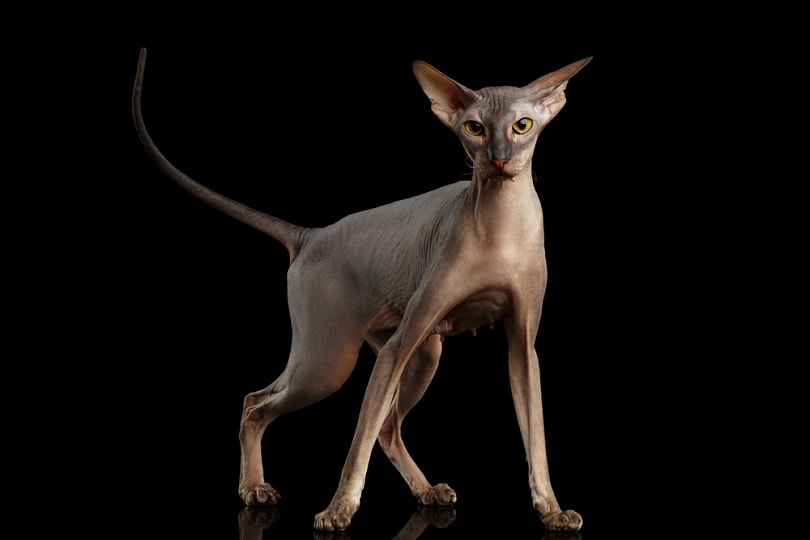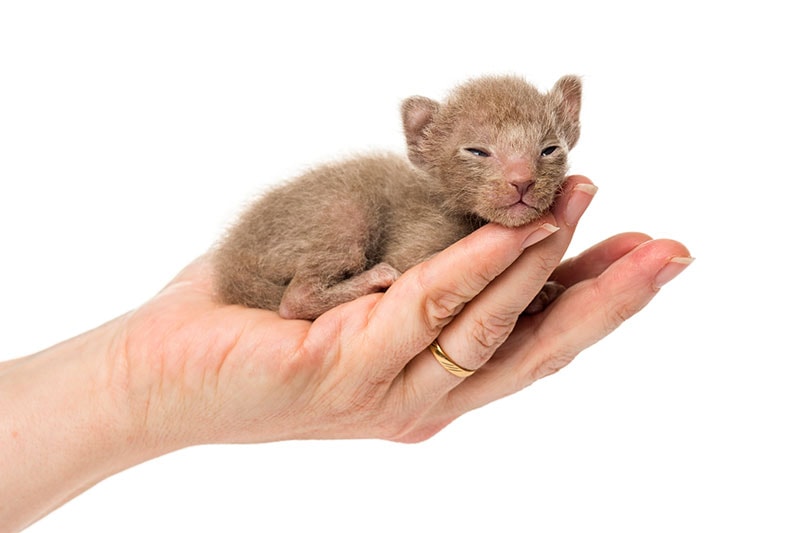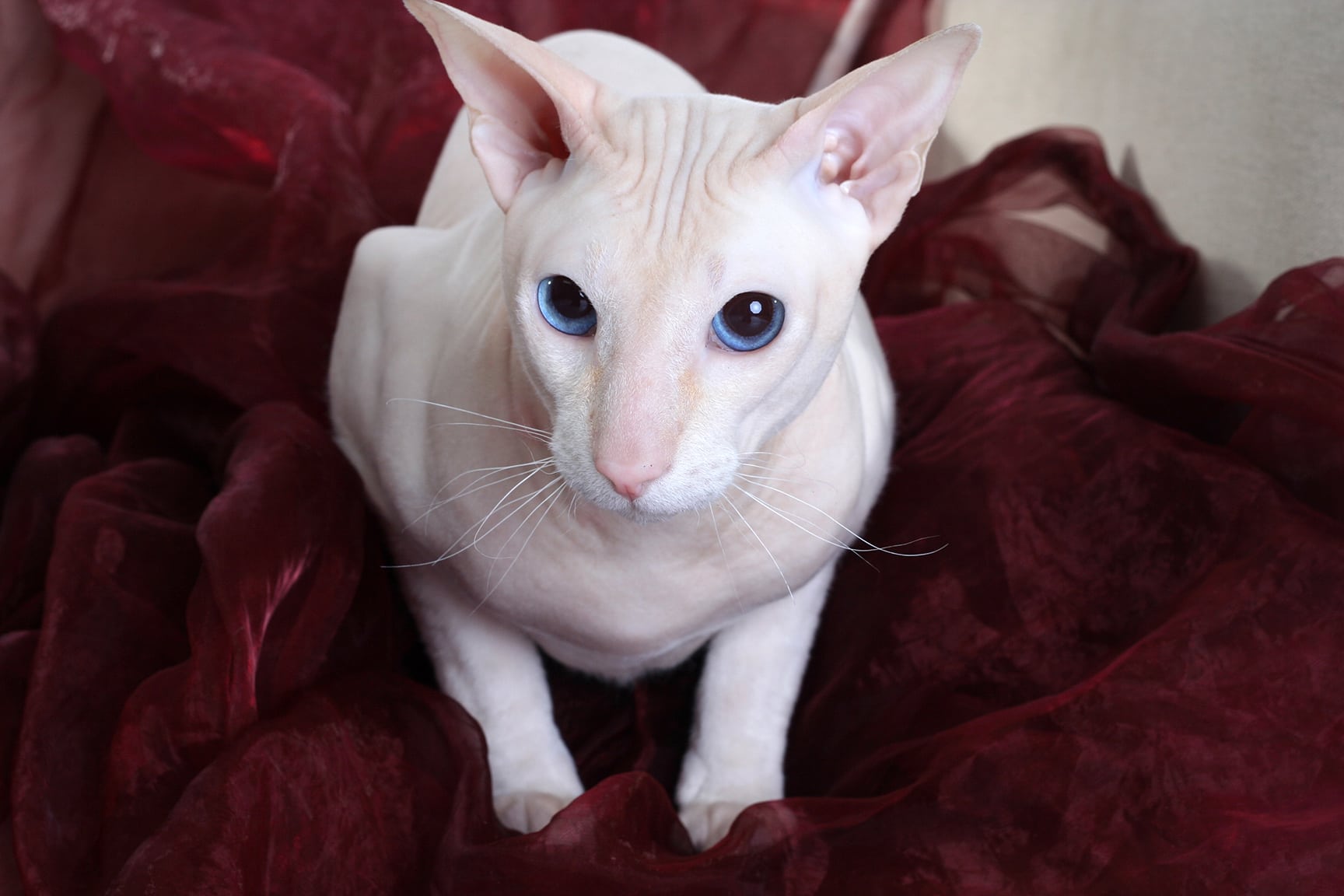
Click Below to Skip Ahead
When staring into the deep, intense eyes of a Peterbald cat, it’s easy to fall in love with this fascinating breed. While these cats may be hairless, they have their own distinct features that make them one of the best cat breeds for domestic living.
Breed Overview
Height:
8 – 10 inches
Weight:
7 – 14 pounds
Lifespan:
12 – 15 years
Colors:
White, blue, silver, red, brown, gray, black
Suitable for:
Families with small children, homes with other pets, seniors, small home or apartment owners
Temperament:
Intelligent, playful, friendly, loving
Add in the fact that they are known for their loving nature, intelligence, and playful demeanors, and you may find that a Peterbald is the spirit animal you’ve been searching for. Let’s learn more!
Peterbald Cat Characteristics
Peterbald Kittens

The Peterbald was bred in the early 1990s by breeding the Oriental Shorthair and the Donskoy. The result was a unique, mostly hairless cat that the people of Saint Petersburg, Russia adored. This is where the breed received its name.
Due to its popularity, unique traits, and charming disposition, the Peterbald is in high demand. Unfortunately, this means hefty price tags are often placed on them. This often leads to lower prices for kittens, and the existence of kitten mills. Before you purchase a Peterbald or any pet for that matter, you must know where your pet comes from. Kitten mills are known for unsanitary conditions, tight living spaces, and the constant breeding of purebred cats. Once they are no longer able to produce kittens they are often disposed of. To avoid dealing with kitten mills it is important to properly vet any breeder you decide to purchase from. This will help you avoid unnecessary medical costs due to the unsanitary living conditions your kitten was exposed to and will also help stop these breeders from harming cats and kittens.
Temperament & Intelligence of the Peterbald
The Peterbald is easily one of the most affectionate and loyal cat breeds available. This makes them great companions for any home. They are also known for their vocal nature. If you enjoy talking with your animals, don’t be surprised if your Peterbald talks back to you. They love anything that keeps them in close contact with their owners. Unfortunately, this need for affection can also be the root of separation anxiety in homes where a Peterbald will be left alone for long periods. Ensure that you have the time to dedicate to this breed if you decide to make one part of your family.
Are These Cats Good for Families? 👪
Yes. The Peterbald is ideal for family life. Peterbalds love attention so the more the merrier. If you have small children, however, make sure they know how to properly play with a cat. This will help keep your children and your fur baby safer and avoid any accidents that may result from rough play.

Does This Breed Get Along with Other Pets?
Yes. Peterbald exhibits a great personality around humans and animals. If you already have cats in the home, this breed will fit right in. They can even make friends with the family dog if you have one looking for a snuggle buddy. But in order to avoid tempting fate, we do not recommend putting small rodents or birds in the same room with any cat unsupervised.
Things to Know When Owning a Peterbald:
Being prepared when you bring a new kitten home is important for them to have a happy, healthy life. Here’s a look at the things you should know about your Peterbald before they become part of the family.
Food & Diet Requirements 
Being a hairless cat breed gives Peterbalds a higher metabolism than coated breeds so don’t be surprised if your cat has a big appetite. This is why feeding them the right food is so important. As always, offer your kitten high-quality, high-protein kitten food during their developmental years. When they are ready to make the change to adult cat food, the same quality and protein considerations should also be exercised. Any pet in your home should also have constant access to fresh, clean.
Exercise 🐈
Peterbalds are muscular cats that require daily exercise to keep them fit and healthy. Toys that promote engagement are ideal for these kitties. Whether you use laser pointers, crinkle balls, or feather wands, you should play with your cat routinely to keep them happy.
These cats also need mental stimulation throughout the day. Providing them with lots of affection is a great way to keep them happy. Don’t avoid talking with your Peterbald either. They enjoy your voice and will often vocalize back.

Training 🧶
As we’ve said, Peterbalds are very dog-like. These cats can be trained to find their favorite toys or learn tricks thanks to their high intelligence. Rewarding your Peterbald with high-quality cat treats is a great way to positively reinforce their hard work and strengthen your bond.
Grooming ✂️
Being a hairless cat breed means your Peterbald may suffer from certain skin irritations if you don’t properly groom them. A weekly bath will remove any debris and dirt that may irritate their skin. It’s also important that your Peterbald wears protective sunscreen if they go outdoors in the summer and a warm sweater when things cool down in the winter months.
Health and Conditions 🏥
Luckily, Peterbalds are a relatively healthy cat breed. The biggest concerns they face are skin issues. Protective sunscreens, routine checkups at the vet, and proper grooming will keep your Peterbald feeling its best.
Male vs Female
As with most animals, the male Peterbald will be slightly larger in build than a female of the breed. Luckily, though, that is their biggest difference. The personalities of both the males and females are great. This should make them great additions to the home no matter which sex you prefer.
3 Little-Known Facts About the Peterbald Cat
1. The Peterbald Has Five Coat Variations
While most people consider Peterbalds a completely hairless cat breed, this isn’t the case. Peterbalds actually have 5 coat variations. These variations are also known to change during the first 2 years of a Peterbald’s life meaning they can lose or gain hair as they grow.
2. Nocturne Iz Murino Was the First Peterbald Stud
In 1993, when the first Peterbalds were bred, one kitten became the foundation stud of the entire breed, Nocturne Iz Murino. He is found in every Peterbald pedigree.
3. Peterbalds Are Dog-Like in Terms of Personality
While dogs are considered man’s best friend, the Peterbald cat shares a lot of the same traits. These cats are known to be highly affectionate with their owners and want to spend most of the day with them. Don’t be surprised if you find your Peterbald following you around the house waiting to lay in your lap or show you some love.

Final Thoughts
The Peterbald is one of the best cat breeds to introduce into the home. Whether you live in a small apartment or a large home, they know how to make themselves part of the family. These cats are great with children, adults, and even other animals. If you’re looking for a cat that is affectionate, loyal, and fun to be around, the Peterbald may be the perfect cat for you and your family.
Featured Image Credit: Seregraff, Shutterstock







